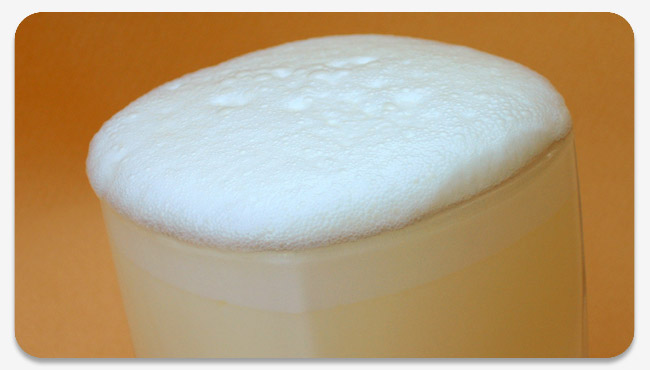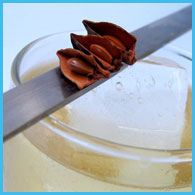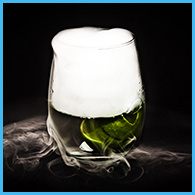MxMo Fizz: New Orleans Fizz No. 1

I have little doubt that one or more of our illustrious group of cocktailians will plunge headfirst into the the history of the gin fizz. If not, Eric Felten does more than a fine job of detailing its origins and downfall in How’s Your Drink? which should be hitting shelves before yuletide. For those of you who haven’t had your eyes glued to an advance readers copy, you’re in for a treat this winter.

This week’s Mixology Monday is being hosted by Gabriel over at Cocktail Nerd. He has such a fine blog, and it brings me pleasure to participate in his fizzy adventures. I knew immediately which book to pull off the shelf …
Baker hosts a whole section on gin fizzes in his fine companion, which features drinks such as the Bird of Paradise tinted with raspberry syrup, the Creole Fizz which relies on sloe gin, and the Gin Fizz Tropical which simply replaces the lemon with lime. The list doesn’t stop there, however. How about the Amer Picon “Pouffle” Fizz or the Fizz a la Violette? I feel good Charles in the room with me, beckoning me to create or find all these holy grail ingredients just to please his whim. “Good sir, it troubles my heart that you don’t have some good homemade picon. Perhaps my manservant can fetch it for you.”
New Orleans Fizz No. 1
- 2 1/4oz gin
- 1oz heavy cream
- 1 egg white
- 1/4 – 1/2oz lemon juice
- 1t sugar or 2t simple syrup
- 1t kirsch
- club soda
Shake hard with lots of cracked ice until your hands are stuck to the frost-crusted shaker and you want to die. Strain into a goblet and top with club soda.
Source: The Gentleman’s Companion Volume II: The Exotic Drinking Book, Charles H. Baker, Jr.
A heavenly array of bubbles fills the glass from base to rim. Each sip is met with the tingle of foam as the white pillow slowly descends down the glass. The kirsch is much more than an afterthought, and definitely provides that “special taste that you can’t identify.”
A Question for the Masses
Baker most often calls for citrus by “half a lime” or “the juice of one lemon.” Considering that early-industrial citrus probably didn’t produce the massive fruits we have today, how do you account for this? Is “half a lemon” 1/2oz? more? What about limes?
7 Responses to “MxMo Fizz: New Orleans Fizz No. 1”
You can leave a response, or trackback from your own site.



“Is “half a lemon” 1/2oz? more? What about limes?….”
I also wonder not only about the size and measures, but the variety and quality of the ‘early’ citrus used in cocktails. Grapefruit is relatively ‘new’ in the US, and Key-Limes were the defacto standard for most of the Eastern Seaboard… But what about the drinks that were created in the Mid West where these things had to be shipped in? What did they have in mind and what did they have in hand?
If I could just find a Delorean and a way to get 1.2 Jigawatts into same Delorean…..
Great post! It fits good to the post of the 9th from Darcy of theartofdrink.com; he considered how dairy is reacting with acidity…
Hey – and the New Orleans Fizz No.1 is also quite similar to the (in)famous Ramos Gin Fizz…
I am quite curious what the others will post. With this Gin Fizz variation, you were first of the ones which are going the “traditional” way.
I was more intrigued by the fizzy world of champagne, I would be pleased, if you are leaving your comment on: opinionated-alchemist.com !
Cheers!
I used to joke that when I started a band, our first album would be Juice of One Half Lime — it’s such an odd turn of phrase.
Thanks for reminding me of the Fizz a la Violette — now that I have the Rothman & Winter, I need to give that one another go.
[…] rick’s new orleans fizz […]
Key limes are confusing things that contain way less juice but are much sourer. They certainly seem more fragrant that the basic American supermarket fruit. I think I like ’em, but haven’t tried to get a decent cocktail out of one. Anybody ever try to substitute them, one for one? (Or maybe I should say 1/2 for 1/2?) Obviously you’d have less volume and the effect would be different, but I’m guessing the sour power might be reasonably equivalent.
Anita–was the Rothman & Winter a mail order thing?
Meant to comment on this post a while ago.
There is so much variability in citrus fruit, that I don’t worry about it too much.
Sometimes you’ll get more juice out of a small lime than a big mealy one. You just have to be prepared to adjust the sweetness. One good trick is to taste the cocktail for balance before shaking. You can do this by using a straw or swizzle stick as a siphon. This allows you to adjust it, without risking over dilution.
I do try to buy smaller lemons and stick with thin skinned, small limes.
Key limes are quite delicious in cocktails. I use about 1 lime per half regular lime.
Another citrus fruit I am particularly taken with is the Calamondin or Kalamansi. Tiny fruit the size of a key lime with a flavor sort of half way between a lime and a Clementine. You can sometimes buy juice concentrate at Asian markets.
[…] this week I missed the heads-up until last night. Rick emailed me to tell me he’d posted the New Orleans Fizz No. 1 and would I like tocontribute some history to the comments. “Oh, feck,” I thought, […]